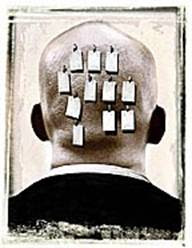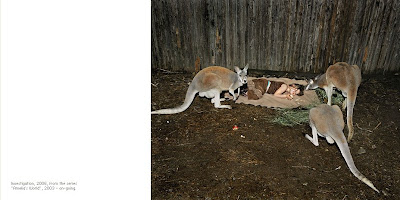 Darius Himes, for about 10 years, was my co-worker at photo-eye and editor of photo-eye Booklist. He is currently an independent curator, writer, consultant and co-founder of Radius Books. (photo shown here by Miriam Romais).
Darius Himes, for about 10 years, was my co-worker at photo-eye and editor of photo-eye Booklist. He is currently an independent curator, writer, consultant and co-founder of Radius Books. (photo shown here by Miriam Romais).
MM: How did you become interested in photography?
DH: I could hear a clicking sound while in my mama's belly and I discovered, after entering this realm of life, it was a camera that produced that sound. So, pursuing photography was just a familiar kind of thing, you know?
MM: You received your undergraduate degree in Photography from ASU where you studied with Bill Jay and Mark Klett. Why did you chose to attend ASU for your undergraduate degree? What do you feel is the most important lesson each taught?
DH: I grew up in a village in Iowa. When I was 18, I simply wanted to get as far away from small-town Iowa as I could. So I applied to ASU (which was a world away from Iowa). Bill Jay taught me how exciting history can be, and to always be diligent and full of humor. Mark Klett didn't teach me anything, because I actually didn't have him for any classes. But Margaret Moore taught me how to make it through Photo 101, Mary Anne Redding and James Hajicek taught me how to run a gallery and handle 19th century photographs, Eric Kronengold taught me how to use bleach and toner and a view camera, and William Jenkins taught me how to think more critically than my farmboy brain had ever thought possible.
MM: Why did you move to Santa Fe?
DH: I came to Santa Fe in 1998 to work with you at photo-eye, Mellie. Duh. No, seriously, I came out to Santa Fe primarily to attend the Graduate Institute at St. John's College, (the best liberal arts college in America). But Santa Fe was a beacon of cool art and photography and I wanted to be in that environment as well, so I stayed after graduation. I was already working for photo-eye part time and was offered a chance to work full-time.
MM: Do you feel conflicted about being a photographer and pursuing other avenues in the photo world? Does your ability and desire to produce images help your understanding and empathy regarding photographers in the projects you choose to promote?
DH: No conflict at all. I feel that because I'm a practitioner, I have a deeper understanding of not only what it takes to make an image but the creative, internal processes that are involved in making work. I still consider myself, first, an artist and photographer, and second, a writer and editor and publisher.

MM: Radius was founded as a not-for-profit organization. Why did your chose to establish the imprint in this way and what is the mission of the organization?
DH: "RADIUS BOOKS encourages, promotes, and publishes books of artistic and cultural value for a wide audience. Our projects are distinguished in both form and substance: beautiful objects by important artists of all ranks." We are non-profit because of our vision that the role of the arts can play in society, which means that we see education and distribution of books to libraries as key to our mission, and those things require funding. Being non-profit allows us to fund-raise to support that mission.
MM: How did Mark Klett's book Saguaros develop as a concept and why did you produce the book with exposed boards and loose binding?
DH: Mark's Saguaros project was something that all of us at Radius had known about for many years. In fact Mark has sent it to me when I was at photo-eye, asking for publisher recommendations. When we were at the design stage, we talked about it needing to be rather large (it's 12x15 inches) but also rather non-traditional. David Chickey suggested the binding, which allows the book to lay very flat and also has a very rigid feel. That rigidity mimics the very rigid, linear profile of the saguaro cacti. The exposed edges of the board also calls to mind the spines and ribs of the cactus plants. It all seemed to come together for that book.
We really try to have the design and the materials complement the subject matter in a conscious, appropriate manner. For example, with Michael Lundgren's new book, Transfigurations, the photographs are very experiential and are all made in the desert. So we used an uncoated paper for the cover, which gives it a very textural, dusty-type feel. We then debossed the word Transfigurations on the cover, in a small font-size, and used a black foil, so that when you look at the title it sort-of shimmers and recedes from your eyes amidst the grays and lights of the desert landscape. It's gorgeous.

MM: Who designs the Radius books? Where are the books printed?
DH: In many ways, the books are created through collaborative processes involving the Radius team (of David Chickey and David Skolkin and Joanna Hurley and myself) as well as the artist. We often start with a concept and then discuss it amongst ourselves, bringing different books to the table as examples of things we're thinking about. The editorial content, such as the overall book concept, editing and sequencing of images, as well as what text to include, and by what writer, is approached in much the same way. But David and David oversee the production of the books. As far as printing is concerned, we have printed books in Italy, Germany, China, Singapore and the U.S.
MM: How do you select your photo projects for Radius? Do you accept submissions?
DH: We accept blind submissions, although this is not a very effective method for finding projects, as most publishers will attest. Generally, the four Radius Books member are all very aware of what's happening in the art world. We read a lot of magazines, travel to art fairs, participate in review events, and just generally try to stay informed. There are, of course, any number of great artists out there that we would love to work with, and some of them we have approached, while others have approached us. MM: How would you recommend that photographers get funding for book projects? Do limited editions help?
DH: The question of funding/financing projects is a complex one. The quickest answer is to say that putting out an "illustrated book" such as what we're doing requires a team of people that generally can include galleries, museum curators, collectors, and local arts organizations that like to sponsor great projects.
MM: You recently finished coordinating the judges and symposium for the Photography Book Now competition, sponsored Blurb.com, the premier print-on-demand company based in San Francisco. How do you feel that the POD industry has affected the current publishing industry and do you feel that this will have a positive or negative affect on the future of publishing?
DH: I love it. I wouldn't have gotten involved with the folks at Blurb if I didn't think it was a good thing. POD is a fascinating phenomenon and opportunity for photographers and writers. It's the equivalent of how blogging changed the face—and is still changing—the face of journalism. The Photography Book Now contest proved to everyone that the book is a central form of expression within contemporary photography, and the symposium was an indication that lots of folks are interested in hearing about the book industry overall. It was a lot of fun and it's going to happen again in 2009!
MM: You curated the new issue of Nueva Luz magazine. How did you choose the photographers and the theme of this issue?
DH: This project was actually very dear to me. I was given the chance to curate a group of photographers for Nueva Luz, a magazine that has historically championed underrepresented and minority artists. I proposed writing an essay that addressed the concept of "race" as an identifying concept, and chose four artists that I think are also working in a similar vein (though I wasn't looking for direct corollaries). What emerged was an essay that I'm very proud of and which essentially asks people to consider the thesis, which I'm not pretending to have made up, by any means, that there is one human race made up of people of many colors (and cultures). There is an essential unity that underlies our vast and valuable diversity, and that the unity of humanity is often lost in the mix of discussions about race. You'll have to buy the issue to read the essay and see the work! The photographers included were Sanaz Mazinani, Nontsikelelo Veleko, Hank Willis-Thomas and Ian Ramirez.
MM: What blogs do you read? What magazines?
DH: I read your blog, Mellie, first thing every morning. (I like to look at your profile pic with my coffee.) Just teasing. I have subscriptions to Squash Gardening at Home, This Old Cabin, and Damengambit Quarterly.
MM: Which photographer has had the most impact on your life?
DH: That's impossible for me to answer! Personally, there are numerous photographers and artists that have created shifts in how I understand the visual medium, and those shifts happened at different points in my life. So, in the past decade, spending a great deal of time with the work of Lee Friedlander, Hiroshi Sugimoto, and Martin Parr has dramatically shifted the way I think about the medium. Masao Yamamoto, Stephen Shore and Daido Moriyama have had a definite impact, as has the work of Roger Ballen. And to be honest, the work of Michael Lundgren, whose work we have just released in a new monograph called Transfigurations, is still penetrating into my consciousness. Mike just gave a talk in Tempe at ASU and I was blown away (even though we'd already published the work!). He is thinking about—and photographing—landscape, particularly the desert landscape, in a radically new way. That'll require a separate blog post to discuss.
MM: You have an extensive photo (and non-photo) library. What is your favorite photo book? What is your favorite non-photo book?
DH: Another impossible-to-answer question! I don't have one favorite photobook. I want to be buried with ALL of them. Haha! There are so many gems out there. One overlooked gem of a photobook, which is mostly writing based on photography, is Crime Album Stories by Eugenia Parry. Parry is one of photography's preeminent (and overlooked) writers; this volume was a quasi-fictional book based on groups of police-record photographs found in a 19th century album. I devoured the book when it first came out. As far as authors and literature, I would list the following: Titus Burckhardt, Ananda K. Coomaraswamy, Shoghi Effendi, Aquinas, Plato, and David Sedaris.
MM: Aside from Radius, of course, who are some of your favorite publishers?
DH: Without hesitation I would say, as far as small presses go, that Nazraeli Press, Twin Palms Publishers, Chris Boot, and J&L Books rank as some of the best. On a larger scale, what Lesley Martin has done with Aperture in recent years is nothing short of brilliant, Phaidon books continues to rock the casbah with gorgeous, hard-hitting, well-conceived titles, and who can ignore Steidl? Rathole books is now putting out some seriously interesting titles. And the most underrated publishing program in America is, in my opinion, that of Fraenkel Gallery. I wish I owned everything they've published to date.



































